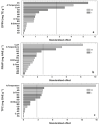Extraction and Characterization of Antioxidant Compounds in Almond (Prunus amygdalus) Shell Residues for Food Packaging Applications
- PMID: 36005720
- PMCID: PMC9416045
- DOI: 10.3390/membranes12080806
Extraction and Characterization of Antioxidant Compounds in Almond (Prunus amygdalus) Shell Residues for Food Packaging Applications
Abstract
This work proposes the revalorization of almond shell (AS) wastes as an active additive for food packaging applications. A new microwave-assisted extraction (MAE) method to obtain extracts rich in polyphenolic compounds with high antioxidant capacity was optimized. An experimental design to optimize the MAE procedure through response surface methodology (RSM) using a Box-Behnken design was proposed. The effects of extraction temperature, irradiation time, ethanol:water concentration, and solvent pH at three levels were evaluated in terms of total phenolic content (TPC) and antioxidant activity (DPPH (2,2-diphenyl-1-picrylhydrazyl) and ferric reducing antioxidant power (FRAP) assays). The optimal conditions found were 57 min, 80 °C, pH 8, and 70% (v/v) ethanol. Optimized MAE extracts showed low soluble protein content (0.43 mg BSA g-1) and were rich in TPC (5.64 mg GAE g-1), flavonoids (1.42 mg CE g-1), and polysaccharides (1.59 mg glucose g-1), with good antioxidant capacity (2.82 mg AAE acid g-1). These results suggest the potential application of these extracts in the food industry as active additives. This strategy opens new pathways to valorize almond shell residues, contributing to the circular economy.
Keywords: Prunus amygdalus; almond; antioxidant compounds; food packaging; microwave-assisted extraction; response surface methodology; shell residues.
Conflict of interest statement
The authors declare no conflict of interest.
Figures





References
-
- Arshad R.N., Abdul-Malek Z., Roobab U., Qureshi M.I., Khan N., Ahmad M.H., Liu Z.W., Aadil R.M. Effective Valorization of Food Wastes and By-Products through Pulsed Electric Field: A Systematic Review. J. Food Proc. Eng. 2021;44:e13629. doi: 10.1111/jfpe.13629. - DOI
-
- Kumar K., Yadav A., Kumar V., Vyas P., Dhaliwal H.S. Food Waste: A Potential Bioresource for Extraction of Nutraceuticals and Bioactive Compounds. Biores. Bioproc. 2017;4:497–509. doi: 10.1186/s40643-017-0148-6. - DOI
-
- Pirayesh H., Khazaeian A. Using Almond (Prunus amygdalus L.) Shell as a Bio-Waste Resource in Wood Based Composite. Compos. B Eng. 2012;43:1475–1479. doi: 10.1016/j.compositesb.2011.06.008. - DOI
-
- Rudra S.G., Nishad J., Jakhar N., Kaur C. Food Industry Waste: Mine of Nutraceuticals. Int. J. Sci. Environ. 2015;4:205–229.
Grants and funding
LinkOut - more resources
Full Text Sources
Research Materials
Miscellaneous

